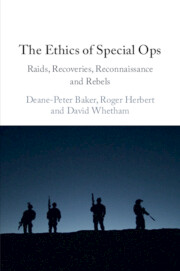Refine search
Actions for selected content:
15401 results in Military history
Chapter 7 - Ethical Armouring for Special Operations Forces
-
- Book:
- The Ethics of Special Ops
- Published online:
- 16 November 2023
- Print publication:
- 30 November 2023, pp 178-217
-
- Chapter
- Export citation
Foreword
-
- Book:
- The Ethics of Special Ops
- Published online:
- 16 November 2023
- Print publication:
- 30 November 2023, pp vi-vii
-
- Chapter
- Export citation
Acknowledgements
-
- Book:
- The Ethics of Special Ops
- Published online:
- 16 November 2023
- Print publication:
- 30 November 2023, pp viii-ix
-
- Chapter
- Export citation
Abbreviations
-
- Book:
- The Ethics of Special Ops
- Published online:
- 16 November 2023
- Print publication:
- 30 November 2023, pp x-xii
-
- Chapter
- Export citation
References
-
- Book:
- The Ethics of Special Ops
- Published online:
- 16 November 2023
- Print publication:
- 30 November 2023, pp 218-230
-
- Chapter
- Export citation
Index
-
- Book:
- The Ethics of Special Ops
- Published online:
- 16 November 2023
- Print publication:
- 30 November 2023, pp 231-234
-
- Chapter
- Export citation
Chapter 3 - Recoveries
-
- Book:
- The Ethics of Special Ops
- Published online:
- 16 November 2023
- Print publication:
- 30 November 2023, pp 53-79
-
- Chapter
- Export citation
Copyright page
-
- Book:
- The Ethics of Special Ops
- Published online:
- 16 November 2023
- Print publication:
- 30 November 2023, pp iv-iv
-
- Chapter
- Export citation
Contents
-
- Book:
- The Ethics of Special Ops
- Published online:
- 16 November 2023
- Print publication:
- 30 November 2023, pp v-v
-
- Chapter
- Export citation
Chapter 4 - Reconnaissance
-
- Book:
- The Ethics of Special Ops
- Published online:
- 16 November 2023
- Print publication:
- 30 November 2023, pp 80-117
-
- Chapter
- Export citation
Chapter 6 - Not Quite War
-
- Book:
- The Ethics of Special Ops
- Published online:
- 16 November 2023
- Print publication:
- 30 November 2023, pp 143-177
-
- Chapter
- Export citation

The Ethics of Special Ops
- Raids, Recoveries, Reconnaissance, and Rebels
-
- Published online:
- 16 November 2023
- Print publication:
- 30 November 2023
Epilogue
-
- Book:
- Uncertain Warriors
- Published online:
- 19 October 2023
- Print publication:
- 09 November 2023, pp 251-269
-
- Chapter
- Export citation
4 - Downsizing, Recruiting and Debates over Military Service
-
- Book:
- Uncertain Warriors
- Published online:
- 19 October 2023
- Print publication:
- 09 November 2023, pp 139-178
-
- Chapter
- Export citation
1 - The Post-Vietnam Recovery, Operation Desert Storm and the Veneration of the Volunteer Soldier
-
- Book:
- Uncertain Warriors
- Published online:
- 19 October 2023
- Print publication:
- 09 November 2023, pp 18-59
-
- Chapter
- Export citation
6 - The Warrior Ethos
-
- Book:
- Uncertain Warriors
- Published online:
- 19 October 2023
- Print publication:
- 09 November 2023, pp 216-250
-
- Chapter
- Export citation
3 - Warriors Who Don’t Fight
-
- Book:
- Uncertain Warriors
- Published online:
- 19 October 2023
- Print publication:
- 09 November 2023, pp 101-138
-
- Chapter
- Export citation
5 - Technological Transformation and the American Soldier
-
- Book:
- Uncertain Warriors
- Published online:
- 19 October 2023
- Print publication:
- 09 November 2023, pp 179-215
-
- Chapter
- Export citation
Acknowledgements
-
- Book:
- Uncertain Warriors
- Published online:
- 19 October 2023
- Print publication:
- 09 November 2023, pp ix-xii
-
- Chapter
- Export citation
Copyright page
-
- Book:
- Uncertain Warriors
- Published online:
- 19 October 2023
- Print publication:
- 09 November 2023, pp iv-iv
-
- Chapter
- Export citation
